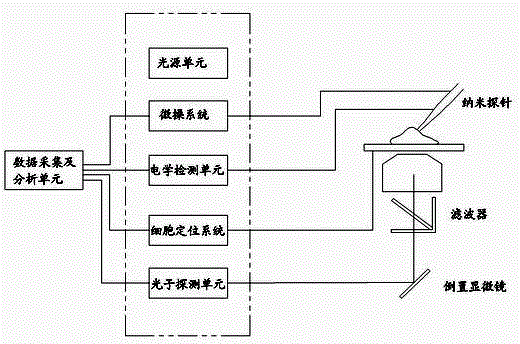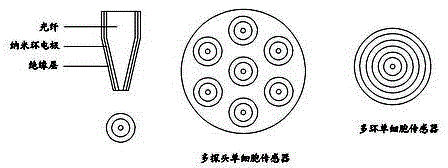Unicell detector based on nano fiber probe and its probe manufacturing method
A nano-fiber probe and nano-probe technology, which is applied in the direction of nanotechnology for sensing, nanotechnology, nanotechnology, etc., can solve the problem that real-time monitoring cannot be realized, the size of a single cell is small, and it is not enough to find the difference at the level of a single cell issues such as improved spatiotemporal resolution and detectable target range, high sensitivity, and reduced cell sample volume
- Summary
- Abstract
- Description
- Claims
- Application Information
AI Technical Summary
Problems solved by technology
Method used
Image
Examples
Embodiment 1
[0039] The present invention develops a lactate dehydrogenase-based fiber optic nanosensor to realize lactate analysis of single cancer cells. Firstly, a polymer brush is modified on the nanoprobe to increase the immobilization amount on the nano-tip of the lactate dehydrogenase nanofiber sensor. The fluorescent by-product NADH produced by the dehydrogenase while promoting the conversion of lactate can be used for Determine the lactic acid concentration. The nanofiber sensor can achieve high spatial resolution, low background interference, and wide dynamic range (0.06-3mM) suitable for the physiological range of single-cell lactate secretion. The sensor successfully detected the diffusion curve of extracellular lactate and could clearly distinguish the lactate secretion levels of different cells such as two breast cancer cells, as Figure 4 as shown, Figure 4 The left figure in the center is the standard curve for lactate detection of nanoprobes modified with polymer brushe...
Embodiment 2
[0041] The single-cell detector of the present invention can not only be used for the research of animal cells, but also suitable for the single-cell detection of fungi and bacteria due to its nano-level probes. different subcellular locations. like Figure 5 As shown, at different hyphal sites, the measured fluorescence intensities are quite different, spanning several orders of magnitude, Figure 5 For the detection of fluorescence at the subcellular level in a single fungal cell, the fluorescence intensity of the subcellular sites (1-6) in the hyphae varies greatly. This preliminary result suggests that the fluorescent signals at subcellular sites are most likely related to key sites of neolamina metabolism. More in-depth single-cell analysis has great potential in revealing key sites and key genes in mycotoxin synthesis in cells, single-cell heterogeneity of enzymes, and the mechanism of mycotoxin cell-to-cell spread infection.
Embodiment 3
[0043] The probe combines nanoring electrodes and fiber optic sensors to simultaneously detect electrical and optical signals with high spatial resolution in real time. Figure 6 It is used for synchronous photoelectric detection of calcium ion level changes and dopamine release in PC12 cells. (a) Typical current response derived from dopamine release and (c) calcium ion fluorescence signal; (b, d) are the corresponding statistical analysis results (N = 10). a: A 24 hours after NGF withdrawal, b: Differentiation in culture medium containing 100ng / mL NGF for 3 days, c: Cells after drug withdrawal were incubated in culture medium supplemented with 150μM L-DOPA for 60 minutes . Arrows indicate the time points of high potassium solution addition. Error bars represent standard deviation; ** and * indicate p Figure 6 As shown in a and c, in the degenerated PC12 cells, not only the calcium influx was significantly reduced, but also the dopamine secretion was much reduced compared ...
PUM
| Property | Measurement | Unit |
|---|---|---|
| diameter | aaaaa | aaaaa |
Abstract
Description
Claims
Application Information
 Login to View More
Login to View More - R&D
- Intellectual Property
- Life Sciences
- Materials
- Tech Scout
- Unparalleled Data Quality
- Higher Quality Content
- 60% Fewer Hallucinations
Browse by: Latest US Patents, China's latest patents, Technical Efficacy Thesaurus, Application Domain, Technology Topic, Popular Technical Reports.
© 2025 PatSnap. All rights reserved.Legal|Privacy policy|Modern Slavery Act Transparency Statement|Sitemap|About US| Contact US: help@patsnap.com



